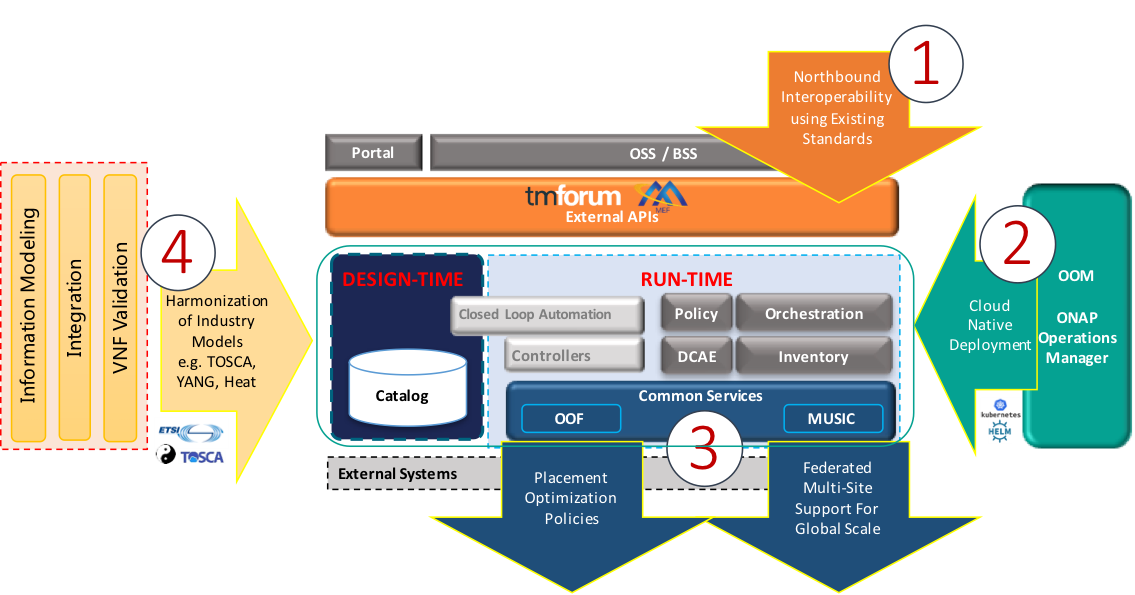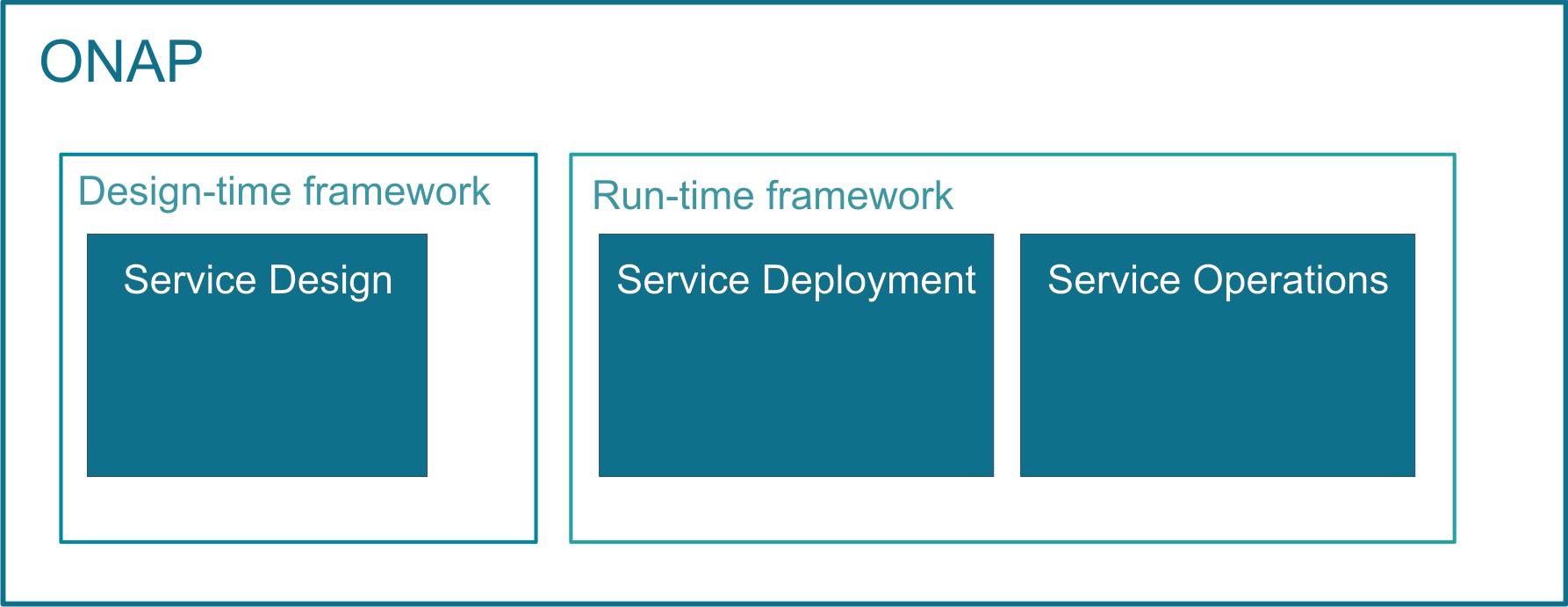...
ONAP’s major activities, that is designing, deploying and operating services, are provided based on ONAP’s two major frameworks, namely on Design-time framework and Run-time framework:
Figure 1
ONAP Functional Architecture
Figure 2 below, provides a simplified functional view of the architecture, which highlights the role of a few key components:
- Design time environment for onboarding services and resources into ONAP and designing required services.
- External API provides northbound interoperability for the ONAP Platform and Multi-VIM/Cloud provides cloud interoperability for the ONAP workloads
- OOM provides the ability to manage cloud-native installation and deployments to Kubernetes-managed cloud environments.
- ONAP Shared Services provides shared capabilities for ONAP modules. MUSIC allows ONAP to scale to multi-site environments to support global scale infrastructure requirements. The ONAP Optimization Framework (OOF) provides a declarative, policy-driven approach for creating and running optimization applications like Homing/Placement, and Change Management Scheduling Optimization. Logging provides centralized logging capabilities, Audit (POMBA) provides capabilities to understand orchestration actions.
- ONAP shared utilities provide utilities for the support of the ONAP components.
- Information Model and framework utilities continue to evolve to harmonize the topology, workflow, and policy models from a number of SDOs including ETSI NFV MANO, TM Forum SID, ONF Core, OASIS TOSCA, IETF, and MEF.
Figure 2
Functional View of the ONAP latest release
The Latest release of ONAP has a number of important new features in the areas of design time and runtime, ONAP installation, and S3P.
- Design time: ONAP has evolved the controller design studio, as part of the controller framework, which enables a model driven approach for how an ONAP controller controls the network resources.
- Runtime: Service Orchestration (SO) and controllers have new functionality to support physical network functions (PNFs), reboot, traffic migration, expanded hardware platform awareness (HPA), cloud agnostic intent capabilities, improved homing service, SDN geographic redundancy, scale-out and edge cloud onboarding. This will expand the actions available to support lifecycle management functionality, increase performance and availability, and unlock new edge automation and 5G use cases. With support for ETSI NFV-SOL003, the introduction of an ETSI compliant VNFM is simplified.
- VES Enhancements: To facilitate VNF vendor integration, ONAP introduced some mapper components that translate specific events (SNMP traps, telemetry, 3 GPP PM) towards ONAP VES standardized events.
- Policy: The Policy project supports multiple policy engines and can distribute policies through policy design capabilities in SDC, simplifying the design process. Next, the Holmes alarm correlation engine continues to support a GUI functionality via scripting to simplify how rapidly alarm correlation rules can be developed.
- External APIs: ONAP northbound API continues to align better with TM Forum APIs (Service Catalog, Service Inventory, Service Order and Hub API) and MEF APIs (around Legato and Interlude APIs) to simplify integration with OSS/BSS. The VID and UUI operations GUI projects can support a larger range of lifecycle management actions through a simple point and click interface allowing operators to perform more tasks with ease.
- Close Loop: The CLAMP project supports a dashboard to view DMaaP and other events during design and runtime to ease the debugging of control-loop automation.
- Service Mesh Support: ONAP has experimentally introduced ISTIO in certain components to progress the introduction of Service Mesh.
- ONAP installation: The ONAP Operations Manager (OOM) continues to make progress in streamlining ONAP installation by using Kubernetes (Docker and Helm Chart technologies). OOM supports pluggable persistent storage including GlusterFS, providing users with more storage options. In a multi-node deployment, OOM allows more control on the placement of services based on available resources or node selectors. Finally, OOM now supports backup/restore of an entire k8s deployment thus introducing data protection.
- Deployability: Dublin continued the 7 Dimensions momentum (Stability, Security, Scalability, Performance; and Resilience, Manageability, and Usability) from the prior to the Beijing release. A new logging project initiative called Post Orchestration Model Based Audit (POMBA), can check for deviations between design and ops environments thus increasing network service reliability. Numerous other projects ranging from Logging, SO, VF-C, A&AI, Portal, Policy, CLAMP and MSB have a number of improvements in the areas of performance, availability, logging, move to a cloud-native architecture, authentication, stability, security, and code quality. Finally, versions of OpenDaylight and Kafka that are integrated into ONAP were upgraded to the Oxygen and v0.11 releases providing new capabilities such as P4 and data routing respectively.
...
In order to design, deploy and operate services and assure these dynamic services, ONAP activities are built up as follows:
- Service design – Service design is built on a robust design framework that allows specification of the service in all aspects – modeling the resources and relationships that make up the service, specifying the policy rules that guide the service behavior, specifying the applications, analytic and closed control loop events needed for the elastic management of the service.
- Service deployment – Service deployment is built on an orchestration and control framework that is policy-driven (Service Orchestrator and Controllers) to provide automated instantiation of the service when needed and managing service demands in an elastic manner.
- Service operations – Service operations are built on an analytic framework that closely monitors the service behavior during the service lifecycle based on the specified design, analytics and policies to enable response as required from the control framework, to deal with situations ranging from those that require healing to those that require scaling of the resources to elastically adjust to demand variations.
ONAP enables product- or service-independent capabilities for design, deployment and operation, in accordance with the following foundational principles:
- Ability to dynamically introduce full service lifecycle orchestration (design, provisioning and operation) and service API for new services and technologies without the need for new platform software releases or without affecting operations for the existing services
- Carrier-grade scalability including horizontal scaling (linear scale-out) and distribution to support large number of services and large networks
- Metadata-driven and policy-driven architecture to ensure flexible and automated ways in which capabilities are used and delivered
- The architecture shall enable sourcing best-in-class components
- Common capabilities are ‘developed’ once and ‘used’ many times
- Core capabilities shall support many diverse services and infrastructures
- The architecture shall support elastic scaling as needs grow or shrink
ONAP Functional Architecture
3.3 OpenDaylight
Editor: Abhijit Kumbhare
...

